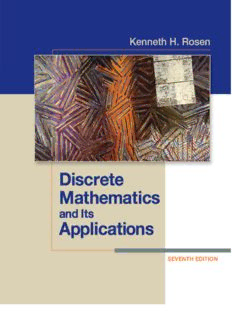
Discrete Mathematics Applications PDF
Preview Discrete Mathematics Applications
KennethH.Rosen Discrete Mathematics andIts Applications SEVENTHEDITION Discrete Mathematics and Its Applications Seventh Edition Kenneth H. Rosen MonmouthUniversity (andformerlyAT&TLaboratories) DISCRETEMATHEMATICSANDITSAPPLICATIONS,SEVENTHEDITION PublishedbyMcGrawHill,abusinessunitofTheMcGrawHillCompanies,Inc.,1221Avenueofthe Americas,NewYork,NY10020.Copyright©2012byTheMcGrawHillCompanies,Inc.Allrightsreserved. Previouseditions©2007,2003,and1999.Nopartofthispublicationmaybereproducedordistributed inanyformorbyanymeans,orstoredinadatabaseorretrievalsystem,withoutthepriorwrittenconsentof TheMcGrawHillCompanies,Inc.,including,butnotlimitedto,inanynetworkorotherelectronicstorage ortransmission,orbroadcastfordistancelearning. Someancillaries,includingelectronicandprintcomponents,maynotbeavailabletocustomersoutsidethe UnitedStates. Thisbookisprintedonacidfreepaper. 1234567890DOW/DOW10987654321 ISBN 9780073383095 MHID 0073383090 VicePresident&EditorinChief:MartyLange EditorialDirector:MichaelLange GlobalPublisher:RaghothamanSrinivasan ExecutiveEditor:BillStenquist DevelopmentEditors:LorraineK.Buczek/RoseKernan SeniorMarketingManager:CurtReynolds ProjectManager:RobinA.Reed Buyer:SandyLudovissy DesignCoordinator:BrendaA.Rolwes Coverpainting:JasperJohns,BetweentheClockandtheBed,1981.OilonCanvas(72 12614inches) × Collectionoftheartist.PhotographbyGlennStiegelman.CoverArt©JasperJohns/LicensedbyVAGA,NewYork,NY CoverDesigner:StudioMontage,St.Louis,Missouri LeadPhotoResearchCoordinator:CarrieK.Burger MediaProjectManager:TammyJuran ProductionServices/Compositor:RPKEditorialServices/PreTeX,Inc. Typeface:10.5/12TimesRoman Printer:R.R.Donnelley Allcreditsappearingonthispageorattheendofthebookareconsideredtobeanextensionofthecopyrightpage. LibraryofCongressCataloginginPublicationData Rosen,KennethH. Discretemathematicsanditsapplications/KennethH.Rosen.—7thed. p.cm. Includesindex. ISBN0–07–338309–0 1.Mathematics.2.Computerscience—Mathematics.I.Title. QA39.3.R672012 511–dc22 2011011060 www.mhhe.com AbouttheAuthorvi Prefacevii TheCompanionWebsitexvi TotheStudentxvii 1 TheFoundations:LogicandProofs..................................1 1.1 PropositionalLogic............................................................1 1.2 ApplicationsofPropositionalLogic.............................................16 1.3 PropositionalEquivalences .................................................... 25 1.4 PredicatesandQuantifiers.....................................................36 1.5 NestedQuantifiers............................................................57 1.6 RulesofInference ............................................................69 1.7 IntroductiontoProofs.........................................................80 1.8 ProofMethodsandStrategy....................................................92 EndofChapterMaterial.....................................................109 2 BasicStructures:Sets,Functions,Sequences,Sums,andMatrices.115 2.1 Sets........................................................................115 2.2 SetOperations...............................................................127 2.3 Functions...................................................................138 2.4 SequencesandSummations...................................................156 2.5 CardinalityofSets...........................................................170 2.6 Matrices....................................................................177 EndofChapterMaterial.....................................................185 3 Algorithms........................................................191 3.1 Algorithms..................................................................191 3.2 TheGrowthofFunctions.....................................................204 3.3 ComplexityofAlgorithms....................................................218 EndofChapterMaterial.....................................................232 4 NumberTheoryandCryptography................................237 4.1 DivisibilityandModularArithmetic...........................................237 4.2 IntegerRepresentationsandAlgorithms........................................245 4.3 PrimesandGreatestCommonDivisors ........................................ 257 4.4 SolvingCongruences.........................................................274 4.5 ApplicationsofCongruences..................................................287 4.6 Cryptography............................................................... 294 EndofChapterMaterial.....................................................306 iii iv Contents 5 InductionandRecursion .......................................... 311 5.1 MathematicalInduction......................................................311 5.2 StrongInductionandWellOrdering...........................................333 5.3 RecursiveDefinitionsandStructuralInduction..................................344 5.4 RecursiveAlgorithms........................................................360 5.5 ProgramCorrectness.........................................................372 EndofChapterMaterial.....................................................377 6 Counting..........................................................385 6.1 TheBasicsofCounting.......................................................385 6.2 ThePigeonholePrinciple.....................................................399 6.3 PermutationsandCombinations...............................................407 6.4 BinomialCoefficientsandIdentities...........................................415 6.5 GeneralizedPermutationsandCombinations...................................423 6.6 GeneratingPermutationsandCombinations....................................434 EndofChapterMaterial.....................................................439 7 DiscreteProbability...............................................445 7.1 AnIntroductiontoDiscreteProbability ........................................ 445 7.2 ProbabilityTheory...........................................................452 7.3 Bayes’Theorem.............................................................468 7.4 ExpectedValueandVariance..................................................477 EndofChapterMaterial.....................................................494 8 AdvancedCountingTechniques...................................501 8.1 ApplicationsofRecurrenceRelations..........................................501 8.2 SolvingLinearRecurrenceRelations..........................................514 8.3 DivideandConquerAlgorithmsandRecurrenceRelations.......................527 8.4 GeneratingFunctions........................................................537 8.5 Inclusion–Exclusion.........................................................552 8.6 ApplicationsofInclusion–Exclusion...........................................558 EndofChapterMaterial.....................................................565 9 Relations..........................................................573 9.1 RelationsandTheirProperties................................................573 9.2 naryRelationsandTheirApplications.........................................583 9.3 RepresentingRelations.......................................................591 9.4 ClosuresofRelations ........................................................ 597 9.5 EquivalenceRelations........................................................607 9.6 PartialOrderings ............................................................ 618 EndofChapterMaterial.....................................................633 Contents v 10 Graphs ............................................................ 641 10.1 GraphsandGraphModels....................................................641 10.2 GraphTerminologyandSpecialTypesofGraphs................................651 10.3 RepresentingGraphsandGraphIsomorphism..................................668 10.4 Connectivity................................................................678 10.5 EulerandHamiltonPaths.....................................................693 10.6 ShortestPathProblems.......................................................707 10.7 PlanarGraphs...............................................................718 10.8 GraphColoring..............................................................727 EndofChapterMaterial.....................................................735 11 Trees...............................................................745 11.1 IntroductiontoTrees.........................................................745 11.2 ApplicationsofTrees.........................................................757 11.3 TreeTraversal...............................................................772 11.4 SpanningTrees..............................................................785 11.5 MinimumSpanningTrees....................................................797 EndofChapterMaterial.....................................................803 12 BooleanAlgebra...................................................811 12.1 BooleanFunctions...........................................................811 12.2 RepresentingBooleanFunctions..............................................819 12.3 LogicGates.................................................................822 12.4 MinimizationofCircuits ..................................................... 828 EndofChapterMaterial.....................................................843 13 ModelingComputation ........................................... 847 13.1 LanguagesandGrammars....................................................847 13.2 FiniteStateMachineswithOutput.............................................858 13.3 FiniteStateMachineswithNoOutput.........................................865 13.4 LanguageRecognition .......................................................878 13.5 TuringMachines.............................................................888 EndofChapterMaterial.....................................................899 Appendixes ....................................................... A1 1 AxiomsfortheRealNumbersandthePositiveIntegers............................1 2 ExponentialandLogarithmicFunctions..........................................7 3 Pseudocode..................................................................11 SuggestedReadingsB1 AnswerstoOddNumberedExercisesS1 PhotoCreditsC1 IndexofBiographiesI1 IndexI2 K ennethH.RosenhashadalongcareerasaDistinguishedMemberoftheTechnicalStaff atAT&TLaboratoriesinMonmouthCounty,NewJersey.Hecurrentlyholdstheposition ofVisitingResearchProfessoratMonmouthUniversity,whereheteachesgraduatecoursesin computerscience. Dr.RosenreceivedhisB.S. inMathematicsfromtheUniversityofMichigan,AnnArbor (1972),andhisPh.D.inMathematicsfromM.I.T.(1976),wherehewrotehisthesisinthearea ofnumbertheoryunderthedirectionofHaroldStark.BeforejoiningBellLaboratoriesin1982, heheldpositionsattheUniversityofColorado,Boulder;TheOhioStateUniversity,Columbus; and the University of Maine, Orono, where he was an associate professor of mathematics. WhileworkingatAT&TLabs,hetaughtatMonmouthUniversity,teachingcoursesindiscrete mathematics,codingtheory,anddatasecurity.Hecurrentlyteachescoursesinalgorithmdesign andincomputersecurityandcryptography. Dr.Rosenhaspublishednumerousarticlesinprofessional journalsinnumbertheoryand inmathematicalmodeling.HeistheauthorofthewidelyusedElementaryNumberTheoryand ItsApplications,publishedbyPearson,currentlyinitssixthedition,whichhasbeentranslated intoChinese.HeisalsotheauthorofDiscreteMathematicsandItsApplications,publishedby McGrawHill,currently in itsseventhedition.Discrete Mathematics and ItsApplicationshas soldmorethan350,000copiesinNorthAmericaduringitslifetime,andhundredsofthousands of copies throughout the rest of the world. This book has also been translated into Spanish, French,Greek,Chinese,Vietnamese,andKorean.HeisalsocoauthorofUNIX:TheComplete Reference;UNIXSystemVRelease4:AnIntroduction;andBestUNIXTipsEver,allpublishedby OsborneMcGrawHill.Thesebookshavesoldmorethan150,000copies,withtranslationsinto Chinese,German,Spanish,andItalian.Dr.RosenisalsotheeditoroftheHandbookofDiscrete andCombinatorialMathematics,publishedbyCRCPress,andheistheadvisoryeditorofthe CRCseriesofbooksindiscretemathematics,consistingofmorethan55volumesondifferent aspectsofdiscretemathematics,mostofwhichareintroducedinthisbook.Dr.Rosenservesasan AssociateEditorforthejournalDiscreteMathematics,whereheworkswithsubmittedpapersin severalareasofdiscretemathematics,includinggraphtheory,enumeration,andnumbertheory. Heisalsointerestedinintegratingmathematicalsoftwareintotheeducationalandprofessional environments, and worked on several projects withWaterloo Maple Inc.’s MapleTM software in both these areas. Dr. Rosen has also worked with several publishing companies on their homeworkdeliveryplatforms. AtBellLaboratoriesandAT&TLaboratories,Dr.Rosenworkedonawiderangeofprojects, includingoperationsresearchstudies,productlineplanningforcomputersanddatacommuni cationsequipment,andtechnologyassessment.HehelpedplanAT&T’sproductsandservicesin theareaofmultimedia,includingvideocommunications,speechrecognition,speechsynthesis, andimagenetworking.HeevaluatednewtechnologyforusebyAT&Tanddidstandardswork intheareaofimagenetworking.Healsoinventedmanynewservices,andholdsmorethan55 patents.OneofhismoreinterestingprojectsinvolvedhelpingevaluatetechnologyfortheAT&T attractionthatwaspartofEPCOTCenter. vi I nwritingthisbook,Iwasguidedbymylongstanding experienceandinterestinteaching discrete mathematics. For the student, my purpose was to present material in a precise, readable manner, with the concepts and techniquesof discrete mathematicsclearly presented anddemonstrated.Mygoalwastoshowtherelevanceandpracticalityofdiscretemathematics tostudents,whoareoftenskeptical.Iwantedtogivestudentsstudyingcomputerscienceallof themathematicalfoundationstheyneedfortheirfuturestudies.Iwantedtogivemathematics students an understanding of important mathematical concepts together with a sense of why these concepts are important for applications.And most importantly, I wanted to accomplish thesegoalswithoutwateringdownthematerial. Fortheinstructor,mypurposewastodesignaflexible,comprehensiveteachingtoolusing provenpedagogicaltechniquesinmathematics.Iwantedtoprovideinstructorswithapackage ofmaterialsthattheycouldusetoteachdiscretemathematicseffectivelyandefficientlyinthe most appropriatemannerfortheirparticularsetofstudents.Ihope that Ihave achievedthese goals. Ihavebeenextremelygratifiedbythetremendoussuccessofthistext.Themanyimprove mentsintheseventheditionhavebeenmadepossiblebythefeedbackandsuggestionsofalarge numberofinstructorsandstudentsatmanyofthemorethan600NorthAmericanschools,and atanymanyuniversitiesinpartsoftheworld,wherethisbookhasbeensuccessfullyused. Thistextisdesignedforaoneortwotermintroductorydiscretemathematicscoursetaken bystudentsinawidevarietyofmajors,includingmathematics,computerscience,andengineer ing.Collegealgebraistheonlyexplicitprerequisite,althoughacertaindegreeofmathematical maturityisneededtostudydiscretemathematicsinameaningfulway.Thisbookhasbeende signedtomeettheneedsofalmostalltypesofintroductorydiscretemathematicscourses.Itis highlyflexibleandextremelycomprehensive.Thebookisdesignednotonlytobeasuccessful textbook, but also to serve as valuable resource students can consult throughout their studies andprofessionallife. Goals of a Discrete Mathematics Course A discrete mathematicscourse has more than one purpose. Students should learn a particular setofmathematicalfactsandhowtoapplythem;moreimportantly,suchacourseshouldteach students how to think logically and mathematically. To achieve these goals, this text stresses mathematical reasoning and the different ways problems are solved. Five important themes areinterwoveninthistext:mathematicalreasoning,combinatorialanalysis,discretestructures, algorithmicthinking,andapplicationsandmodeling.Asuccessfuldiscretemathematicscourse shouldcarefullyblendandbalanceallfivethemes. 1. Mathematical Reasoning: Students must understand mathematical reasoning in order to read,comprehend,andconstructmathematicalarguments.Thistextstartswithadiscussion of mathematical logic, which serves as the foundation for the subsequent discussions of methods of proof. Both the science and the art of constructing proofs are addressed. The technique of mathematical induction is stressed through many different typesof examples of such proofs and a careful explanation of why mathematical induction is a valid proof technique. vii viii Preface 2. CombinatorialAnalysis:Animportantproblemsolvingskillistheabilitytocountorenu merateobjects.Thediscussionofenumerationinthisbookbeginswiththebasictechniques ofcounting.Thestressisonperformingcombinatorialanalysistosolvecountingproblems andanalyzealgorithms,notonapplyingformulae. 3. Discrete Structures:A course in discrete mathematics should teach students how to work with discrete structures, which are the abstract mathematical structures used to represent discrete objects and relationships between these objects. These discrete structures include sets,permutations,relations,graphs,trees,andfinitestatemachines. 4. Algorithmic Thinking: Certain classes of problems are solved by the specification of an algorithm.After an algorithmhas been described, a computer program can be constructed implementingit.Themathematicalportionsofthisactivity,whichincludethespecification of the algorithm, the verification that it works properly, and the analysis of the computer memoryandtimerequiredtoperformit,areallcoveredinthistext.Algorithmsaredescribed usingbothEnglishandaneasilyunderstoodformofpseudocode. 5. ApplicationsandModeling:Discretemathematicshasapplicationstoalmosteveryconceiv able area of study. There are many applications to computer science and data networking in this text, as well as applications to such diverse areas as chemistry, biology, linguistics, geography,business,andtheInternet.Theseapplicationsare naturalandimportantusesof discrete mathematics and are not contrived. Modeling with discrete mathematics is an ex tremelyimportantproblemsolvingskill,whichstudentshavetheopportunitytodevelopby constructingtheirownmodelsinsomeoftheexercises. Changes in the Seventh Edition Although the sixth edition has been an extremely effective text, many instructors, including longtime users, have requested changes designed to make this book more effective. I have devotedasignificantamountoftimeandenergytosatisfytheirrequestsandIhaveworkedhard tofindmyownwaystomakethebookmoreeffectiveandmorecompellingtostudents. The seventh edition is a major revision, with changes based on input from more than 40 formal reviewers, feedback from students and instructors, and author insights.The result is a new edition that offers an improved organization of topics making the book a more effective teaching tool. Substantial enhancements to the material devoted to logic, algorithms, number theory,andgraphtheorymakethisbookmoreflexibleandcomprehensive.Numerouschanges in the seventh edition have been designed to help students more easily learn the material. Additionalexplanationsandexampleshavebeenaddedtoclarifymaterialwherestudentsoften havedifficulty.Newexercises,bothroutineandchallenging,havebeenadded.Highlyrelevant applications,includingmanyrelatedtotheInternet,tocomputerscience,andtomathematical biology,have beenadded.The companionwebsite hasbenefitedfromextensive development activityandnowprovidestoolsstudentscanusetomasterkeyconceptsandexploretheworld of discrete mathematics, and many new tools under development will be released in the year followingpublicationofthisbook. Ihopethatinstructorswillcloselyexaminethisneweditiontodiscoverhowitmightmeet their needs. Although it is impractical to list all the changes in this edition, a brief list that highlightssomekeychanges,listedbythebenefitstheyprovide,maybeuseful. MoreFlexibleOrganization Applicationsofpropositionallogicarefoundinanewdedicatedsection,whichbriefly introduceslogiccircuits. RecurrencerelationsarenowcoveredinChapter2. ExpandedcoverageofcountabilityisnowfoundinadedicatedsectioninChapter2. Preface ix Separatechaptersnowprovideexpandedcoverageofalgorithms(Chapter3)andnumber theoryandcryptography(Chapter4). Moresecondandthirdlevelheadshavebeenusedtobreaksectionsintosmallercoherent parts. ToolsforEasierLearning DifficultdiscussionsandproofshavebeenmarkedwiththefamousBourbaki“dangerous bend”symbolinthemargin. New marginal notes make connections, add interesting notes, and provide advice to students. Moredetailsandaddedexplanations,inbothproofsandexposition,makeiteasierfor studentstoreadthebook. Manynewexercises,both routineand challenging,havebeenadded,while manyex istingexerciseshavebeenimproved. EnhancedCoverageofLogic,Sets,andProof Thesatisfiabilityproblemisaddressedingreaterdepth,withSudokumodeledinterms ofsatisfiability. Hilbert’sGrandHotelisusedtohelpexplainuncountability. Proofsthroughoutthebookhavebeenmademoreaccessiblebyaddingstepsandreasons behindthesesteps. Atemplateforproofsbymathematicalinductionhasbeenadded. Thestepthatappliestheinductivehypothesisinmathematicalinductionproofisnow explicitlynoted. Algorithms Thepseudocodeusedinthebookhasbeenupdated. Explicitcoverageofalgorithmicparadigms,includingbruteforce,greedyalgorithms, anddynamicprograming,isnowprovided. UsefulrulesforbigOestimatesoflogarithms,powers,andexponentialfunctionshave beenadded. NumberTheoryandCryptography Expandedcoverageallowsinstructorstoincludejustalittleoralotofnumbertheory intheircourses. Therelationshipbetweenthemodfunctionandcongruenceshasbeenexplainedmore fully. ThesieveofEratosthenesisnowintroducedearlierinthebook. Linearcongruencesandmodularinversesarenowcoveredinmoredetail. Applicationsofnumbertheory,includingcheckdigitsandhashfunctions,arecovered ingreatdepth. Anewsectiononcryptographyintegratespreviouscoverage,andthenotionofacryp tosystemhasbeenintroduced. Cryptographicprotocols,includingdigitalsignaturesandkeysharing,arenowcovered.
Description: